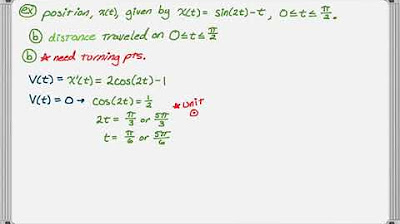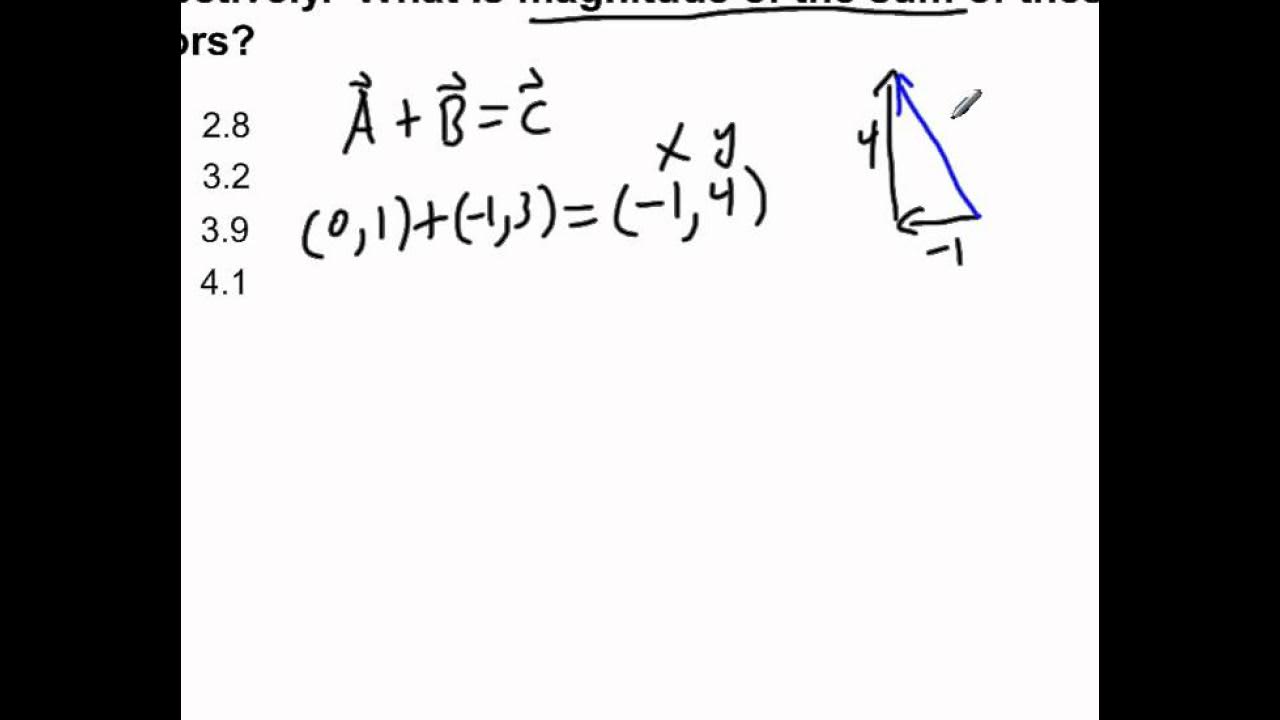How to find the component form and magnitude of a vector
TLDRThe video script provides a detailed explanation on how to calculate the magnitude or distance between two points, specifically points P and Q, in a geometric context. It introduces the concept of the distance formula, which is applicable not only to points but also to vectors. The formula is expressed as the square root of the sum of the squares of the differences in the x and y coordinates of the points. The script further illustrates the process by using an example with points P(4, -7) and Q(-1, 5), showing how to plug the coordinates into the formula to find the magnitude, which in this case is 13. Additionally, it touches on the concept of component form for vectors, explaining that if a vector is already in component form, one can directly calculate its magnitude without the need for conversion. The script concludes by emphasizing the importance of understanding the magnitude of a vector, which represents the distance from the initial to the terminal point, a fundamental concept in vector analysis.
Takeaways
- 📐 The magnitude of a line segment PQ in geometry can be found using the distance formula.
- 🔢 The distance formula is the square root of the sum of the squares of the differences in the x and y coordinates (√((x2 - x1)² + (y2 - y1)²)).
- 📍 When dealing with vectors, the magnitude is calculated in the same way as the distance between two points.
- 🧮 For vectors in component form, the magnitude can be found by taking the square root of the sum of the squares of the vector components (√(v1² + v2²)).
- 📈 The change in x's is calculated as q1 - p1, and the change in y's is calculated as q2 - p2 when plugging into the distance formula.
- 🔴 If given coordinates P(x1, y1) and Q(x2, y2), plug these into the formula to find the distance or magnitude of PQ.
- 📊 An example given in the script is to find the distance between P(4, -7) and Q(-1, 5), which results in a magnitude of 13 units.
- 👉 The component form of a vector is derived from the initial and terminal points, and it's not always necessary to calculate it to find the magnitude.
- 📐 The magnitude of the vector represents the distance from the initial point to the terminal point, regardless of the direction of the vector.
- 🧲 Understanding the concept of vector components and the distance formula is crucial for solving problems involving vectors and their magnitudes.
- ❓ The script invites questions, indicating an interactive approach to learning about vector component form and the calculation of magnitude.
Q & A
What is the main topic discussed in the transcript?
-The main topic discussed in the transcript is the calculation of the magnitude of a vector, specifically using the distance formula to find the length of a line segment PQ in a geometric context.
What is the distance formula used to calculate the magnitude of PQ?
-The distance formula used to calculate the magnitude of PQ is the square root of the change in x's squared plus the change in y's squared, which mathematically is expressed as √[(Q1 - P1)² + (Q2 - P2)²].
How does the component form of a vector relate to the magnitude calculation?
-The component form of a vector is directly related to the magnitude calculation as it represents the vector in terms of its x and y components (V1 and V2). The magnitude can be found by squaring these components and summing them up, then taking the square root of the result (√(V1² + V2²)).
What is the significance of converting a vector to its component form?
-Converting a vector to its component form simplifies the process of finding the magnitude of the vector. It allows for a straightforward application of the distance formula without the need for additional geometric interpretations or conversions.
In the transcript, what are the coordinates of points P and Q used in the example?
-In the transcript, point P has coordinates (4, -7) and point Q has coordinates (-1, 5).
How is the magnitude of the vector PQ calculated in the provided example?
-The magnitude of the vector PQ is calculated by substituting the coordinates of P and Q into the distance formula, resulting in √[(-1 - 4)² + (5 - (-7))²], which simplifies to √[(-5)² + (12)²] and finally to √(169), giving a magnitude of 13.
What is the relationship between the magnitude of a vector and its component form?
-The magnitude of a vector is the length of the vector and is derived from its component form. The component form provides the necessary x and y values (V1 and V2) to calculate the magnitude using the distance formula.
What is the square root of 169 in the context of the magnitude calculation?
-The square root of 169 is 13, which is the final result of the magnitude calculation for the vector PQ in the provided example.
Why is it important to understand the concept of magnitude in vector mathematics?
-Understanding the concept of magnitude is important because it represents the length or size of a vector, which is crucial in various applications such as physics, engineering, and computer graphics where vector lengths are used to represent distances or scales.
Can the magnitude of a vector be negative?
-No, the magnitude of a vector cannot be negative. It is always a non-negative value because it represents the length of the vector, and lengths cannot be negative.
What is the role of the square root in the distance formula?
-The square root is used in the distance formula to obtain the actual distance or length after squaring the differences in the x and y coordinates. It ensures that the result is a positive real number representing the magnitude of the vector.
How does the transcript demonstrate the process of converting a vector from its initial point to its terminal point?
-The transcript demonstrates this process by applying the distance formula to the coordinates of the initial point P and the terminal point Q to find the magnitude, which represents the distance from the initial point to the terminal point of the vector.
Outlines
📐 Understanding Vector Magnitude with the Distance Formula
This paragraph explains the concept of vector magnitude in the context of geometry. It introduces the distance formula as a tool to calculate the magnitude or length of a vector represented by points P and Q. The formula is presented as the square root of the sum of the squared differences in the x and y coordinates of the points. The paragraph also touches on the component form of a vector, showing how to calculate the magnitude from this form as well. An example is given with specific coordinates for points P (4, -7) and Q (-1, 5), and the process of plugging these into the distance formula is demonstrated. The resulting magnitude is found to be 13, which is also the distance between points P and Q. The component form of the vector is shown to be a visual representation of the vector's direction and magnitude.
🔍 Further Clarification on Vector Component Form and Magnitude
The second paragraph provides additional clarification on the concept of vector component form and its relation to the magnitude of a vector. It emphasizes that even though the component form visually represents the direction and magnitude of a vector, the actual numerical distance or magnitude between the initial and terminal points of the vector remains the same, which is 13 in the given example. The paragraph reassures the audience that understanding the component form is not a prerequisite for calculating the magnitude, as the distance formula itself inherently converts the vector into its component form when calculating the magnitude. Any questions regarding this concept are invited, indicating an open opportunity for further discussion.
Mindmap
Keywords
💡Magnitude
💡Distance Formula
💡Vector
💡Component Form
💡Coordinates
💡Initial Point
💡Terminal Point
💡Change in X's and Y's
💡Square Root
💡Geometric Space
💡Line Segment
Highlights
Explains how to find the magnitude (length) of a line segment PQ using the distance formula in geometry.
Shows that the distance formula is also applicable when dealing with vectors to find the distance from the initial to the terminal point.
The distance formula is the square root of (change in x's squared) + (change in y's squared).
When plugging points P(x1, y1) and Q(x2, y2) into the distance formula, it becomes sqrt((x2 - x1)^2 + (y2 - y1)^2).
Provides a real example with P = (4, -7) and Q = (-1, 5) to illustrate finding the magnitude of PQ.
Demonstrates plugging the coordinates into the formula to get the magnitude of PQ as 13.
Mentions that if you already have a vector in component form, you can simply calculate its magnitude as sqrt(v1^2 + v2^2).
Explains that when you plug a vector in component form into the magnitude formula, you are already converting it to component form.
Shows the component form of the vector from the example as <-5, 12>.
Points out that while the component form of a vector is useful, it is not necessary to explicitly find it to calculate the magnitude.
Illustrates that the magnitude or distance from the initial point to the terminal point of a vector remains the same regardless of its component form.
The magnitude of the vector <-5, 12> is also 13, which is the distance from the initial point (0,0) to the terminal point (-5, 12).
Provides a clear, step-by-step explanation of the process for finding the magnitude of a vector or a line segment using the distance formula.
Uses a specific example to make the concept more tangible and easier to understand.
Highlights the key formula components: change in x's squared and change in y's squared.
Explains the concept of component form and how it relates to finding the magnitude of a vector.
Provides additional insights into the vector's component form and its relation to the initial and terminal points.
Summarizes the main points in a concise, easy-to-understand manner.
Transcripts
5.0 / 5 (0 votes)
Thanks for rating:





